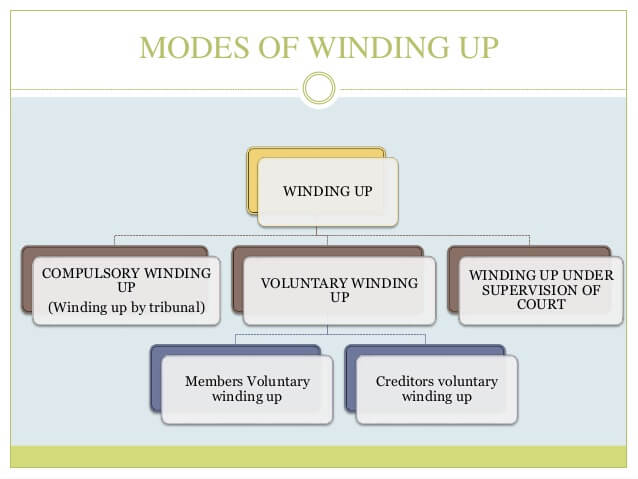
A Report on Procedure of Winding up Partnership Firm
INTRODUCTION:
According to sec.4 of the Indian Partnership Act 1932, “Partnership is the relation between persons who have agreed to share the profits of a business carried on by all of them or any of them acting for all.” Persons who have entered into a partnership are called individually ‘partners’ and collectively a ‘firm.’ The dissolution of a firm means a firm ceases to exist. The relationship existing between the partners discontinues. The whole firm is dissolved, and the partnership terminates. The dissolution of a partnership between all the partners of the firm is called the
‘DISSOLUTION OF THE FIRM’
[sec.39].Dissolution puts an end to the right of the partners to existing as a going concern and is followed by its liquidation. The dissolution of a firm is different from the dissolution of a partnership. The dissolution of the partnership involves a change in the relationship between partners, and a new firm is reconstituted. For, e.g.:- A, B, and C are partners in the firm, and C retires. The partnership between A, B, and C comes to an end, and partnership between A and B comes into being. Thus retirement of a partner does not dissolve the firm. It merely serves the relation between retiring partners and continuing partners.The entire procedure for bringing a lawful end to the life of a company is divided into two stages. These two stages are winding up and dissolution. Winding up of a company is defined as a process by which the life of a company is brought to an end, and its property administered for the benefit of its members and creditors. It is the last stage, putting an end to the life of a company. The main purpose of winding up is to realize the assets and make the payments of the company’s debts fairly. Thus, winding up is the process by which management of a company’s affairs is taken out of its directors, a liquidator realizes its assets, and its debts are discharged out of proceeds of realization.
AIMS AND OBJECTIVES:
The project aims to learn different methods of winding up of partnership firm
Objectives of the study are
- To learn the difference between the dissolution of partnership and dissolution of the firm.
- To learn about Dissolution without the intervention of Court
- To learn about Dissolution on the happening of a contingent event.
- To learn about Dissolution by notice.
- To learn about Dissolution by Court.
METHOD AND METHODOLOGY:
In this project, we are going to learn about different types of winding up of a partnership firm
Primary data is data gathered for the first time by the researcher. It is the raw form of data and thoroughly studied and hence, a helpful tool for secondary data. Here the method used for the collection of primary data is by using the reference of the website.
The referred websites in this project are used as a source of data for this project. Most of the content is collected from these websites. The authenticity of this information cannot be taken seriously, and thus, keeping that in mind, most of that data might be true or fake.

DETAIL REPORT OF PROJECT :
Dissolution of a partnership firm:
Dissolution by Agreement:
A partnership arises from contract and can come to an end by contract. Therefore, the firm may be dissolved with the consent of all the partners or by a contract between the partners.
Dissolution by Notice:
Where the partnership is at will, the firm may be dissolved by any partner giving notice in writing of his intention to dissolve the firm. The firm is dissolved from the date mentioned in the notice as the date of dissolution. An individual partner is empowered to bring an end to the firm.
Dissolution on the happening of certain contingencies:
Subject to contract between the partners, a firm can be dissolved on the happening of the following circumstances :
- Expiry of the term when constituted for a fixed term.
- Completion of the venture or undertaking when the firm constituted to carry on a venture or undertaking.
- Death of a partner.
- Adjudication of a partner as an insolvent.
The partnership agreement may provide that the firm will not be dissolved in any of the above circumstances.
Compulsory Dissolution:
A firm is compulsorily dissolved under any of the following circumstances :
- When all the partners or all but one are adjudged insolvent.
- When the business of the firm becomes unlawful because of the happening of some event.
Dissolution by the Court:
When the partners are having a difference of opinion regarding the dissolution of the firm on certain grounds, a suit can be filed by any partner in the court to dissolve the firm. Depending upon the merits of the matter, the court may order for the dissolution of the firm. Under Section 44 of the Act, the court may dissolve the firm on the following grounds :
Insanity:
When.a partner becomes insane, the court may order to dissolve the firm. The suit can be filed by any of the other partners or even by any friend of the insane partner.
Permanent incapacity:
When a partner becomes permanently incapable of doing his duties as a partner, the court may dissolve the firm. The suit for dissolution must be filed by a partner other than the incapacitated partner.
Misconduct:
When a partner, other than the partner suing, is guilty of misconduct and such misconduct is likely to affect the carrying on of the business, the court may dissolve the firm. The misconduct may be outside the business (punishment for an offense, adultery of a partner, etc.
Persistent breach of agreement:
When a partner persistently or willfully commits the breach of an agreement or conducts himself in such a manner that it is impossible on the part of other partners to carry on the business with him, the court may dissolve the firm. Maintaining wrong accounts, taking away the books of accounts, continuous quarreling with other partners are good grounds.
Transfer of interest:
When a partner transfers his whole interest in the firm to a third party, or all his shares are sold or attached by the court under a decree, the court may dissolve the firm.
Continuous losses:
When the business cannot be carried on except at a loss, the court may dissolve the firm.
Any other ground:
The court may dissolve the firm on any other ground where the court considers it just and equitable to wind up the business.

ANALYSIS OF DATA:
How to wind up a partnership firm
- One has to submit a declaration to Registrar of Companies, stating that the company will pay its dues and liquidation is not to defraud any person. Similar to the one when we submit for the registration of partnership firm
- Within four weeks of such declaration, the special resolution has to be passed for approval of the proposal of voluntary liquidation and appointment of the liquidator
- Within five days of such approval, the public announcement in newspaper and website of the company has to be made for inviting claims of stakeholders
- Within seven days of such approval, intimation should be given to ROC and Board
- Submission of a preliminary report containing capital structure, estimates of assets and liabilities, proposed plan of action within 45 days to a corporate person
- Verification of claims within 30 days and preparation of a list of stakeholders within 45 days from the last date of receipt of claims
- For the receipt of money due to corporate person, a bank account needs to be open in the name of the corporate person having words ‘involuntary liquidation’ after its name.
- Sale of assets and recovery of dues money, uncalled capital is realized
- The proceeds from realization to be distributed within six months from receipt of the amount to the stakeholders
- The final report by the liquidator has to be submitted to the corporate person, ROC, the Board, and application to NCLT.
- The order of NCLT regarding dissolution to be submitted within 14 days of receipt of order.
Here is a list of essential documents required for the formation of a company.
CONCLUSION:
In the year 1999, as per Justice Eradi Committee Report, 473 winding-up cases were pending for more than 25 years, and in 2015, 1479 winding-up cases were pending for more than 20 years, as per data furnished by the Department of Financial Services. The Insolvency and Bankruptcy Code, 2016, was passed to ensure time-bound settlement of insolvency, which would, in turn, help in solving India’s bad debt problem.
To expedite the process of voluntary winding up, the Government had introduced New Regulations as the procedure of voluntary winding up under Companies Act, 1956 was time-consuming, and there was no prescribed qualification for the liquidator. The Code mandates that insolvency professionals are to be appointed as Liquidators, such a move is welcome by corporates and professionals.
The Code and Regulations provide a favorable framework for companies and limited liability partnerships. Though the process remains almost similar to the previous regime, the major change has taken place in the initiation of winding up the process. Earlier, the company or any of its creditors could file a voluntary winding up a petition. Still, now the company, directors, designated partners, or persons responsible for exercising its corporate powers can initiate the winding-up process. Moreover, the approval of creditors representing two-thirds of corporate debt is mandatory under the Code for initiating voluntary winding-up proceedings.
To sum it up, now every company which proposes to wind up is required to follow Insolvency and Bankruptcy Code, 2016. The Code is quite comprehensive and wider as against Companies Act, 1956. It is expected that Code would help in overcoming delays and complexities involved in the process due to the presence of four adjudicating authorities, High Court, Company Law Board, Board for Industrial and Financial Reconstruction, and Debt Recovery Tribunal. It would also lessen the burden on courts as all the litigation will be filed under the Code.
DISCUSSION:
1. Can other partners continue the same business under the same firm name and style?
In the matter of P. Venkateswarlu v. Lakshmi Narshima Rao, AIR 2002 AP 62, the court held that in case of dissolution of the partnership, the firm might be dissolved by any partner giving notice in writing to all the other partners of his intentions to dissolve the firm.
2. If two partners send the notice out of 4, can the remaining two continue?
if no notice is issued section 43 of partnership act then the partner can also move court seeking dissolution of the firm and for taking of accounts under order 20 Rule 15 of CPC
SUGGESTION:
In this case which firms under dissolution then it should take in consideration of the all debtors and receive the money pending and sale all the fixed assets of the firm to paying the debts and all pending liabilities . in that case the company under dissolution will pass the special resolution in boards meeting. All debts of the company paying and fixed assets all sale, and if the company pays its total liabilities, then the company is a solvency company. This is the main suggestions that the company pay its debts and merger and amalgamate with other company.
ACKNOWLEDGMENT :
My profound gratitude to all the faculty members of the Department, for their timely assistance and encouragement throughout my research work.
I duly acknowledge the encouragement and support of the research scholars in the department, and all my colleagues and friends.
It gives me immense pleasure to take the opportunity to all the people who are directly or indirectly involved in the completion of my project based on A Report on Procedure of Winding up Partnership Firm
With deep reverence, I offer my deepest gratitude _____, without whom this project could not have been fulfilled.
Lastly, I thank Almighty, my parents, family members, friends, and teachers for their constant encouragement and support, without which this project would not be possible.
Name of School/College
BIBLIOGRAPHY / REFERENCE :
- https://blog.ipleaders.in/comparative-analysis-winding-company-companies-act-1956-companies-act-2013-insolvency-bankruptcy-code-2016/
- http://www.legalservicesindia.com/article/article/dissolution-of-partnership-firm-1063-1.html
- http://www.preservearticles.com/201101153419/procedures-for-dissolution-of-partnership-firm-in-india.html
In order to download the PDF, You must follow on Youtube. Once done, Click on Submit
Follow On YoutubeSubscribed? Click on Confirm
Download A Report on Procedure of Winding up Partnership Firm PDF







No need to write case study and problems in this topic right??
No need.But if you want you can write one from inc42 website
Thanks
Thanks brother.
This website is very helpful for every HSC students
Thanks
Thank bro
Thanks online hsc project member
Super 😊😀👌👍 really fabulous 🙏🙏🙏🙏🙏👋👏✍️
I am also a HSC student. This is really very helpful for me. “Great job”!!!😀👌👍🙏🙏😊
I am also a hsc student. This is really very helpful for me. “Great job”!!! I really thankful…